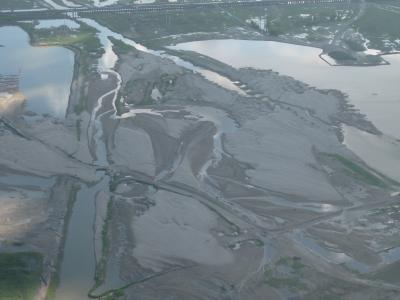CHAMPAIGN, Ill. — Researchers could have a new method to rebuild wetlands of the Louisiana delta, thanks to a chance finding while monitoring severe flooding of the Mississippi River.
A team of civil engineers and geologists from the University of Illinois, in collaboration with the U.S. Army Corps of Engineers, published their findings in the journal Nature Geoscience.
In the spring and summer of 2011, high floodwaters on the Mississippi prompted the corps to open the Bonnet Carre spillway. The spillway had been built to divert water from urban New Orleans after flooding in 1927. The Illinois team saw in the spillway opening a chance to study how much sand flowed from the river into the spillway wetlands.
"Whenever we have such natural disasters, it stresses the human system quite a bit," said Praveen Kumar, a professor of civil and environmental engineering at the U. of I. "But it also offers an opportune time to look at some scientific questions that we might otherwise not be able to explore."
Armed with funds from the National Science Foundation, the researchers went to the spillway site to monitor the sand diverted from the river to the delta wetlands. They discovered a surprising dichotomy: a mere 10 to 15 percent of water from the top of the river sloshed into the spillway, but an estimated 36 to 41 percent of the river's sand load deposited into the Bonnet Carre.
"That was a completely unexpected finding in this particular study," said postdoctoral researcher Jeffrey Nittrouer. "I think one of the real strong outcomes that came from this particular study is that we happened to be lucky about where the site was placed. Back when the structure was built, the Army Corps of Engineers just wanted to get water out of the river. But it turns out that where they decided to place the spillway was a fantastic location for getting sand out as well."

This is an aerial image of the extensive sand deposits in the Bonnet Carré Spillway, exposed after the water had drained and dried from the spillway following floods in 2011. Tire tracks near the bottom of the photo and a railroad track and trestle at the top of the photograph provide scale.
(Photo Credit: Jeffrey Nittrouer)
The findings were exciting to the team, because diverting river sediment has been a goal of research work to build up wetlands. Coastal wetlands act as a natural buffer against storm surges, protecting residential areas from the turbulent weather along the gulf. Under natural conditions, flooding periodically would inundate the wetlands, allowing sediment overflow to deposit incrementally over time to replace ground lost to erosion. However, since the urbanization of New Orleans, the extensively engineered levee system has cut off the river from the wetlands.
"We're essentially putting a straitjacket on the river itself, disconnecting the river from the surrounding environment and preventing these natural exchange processes," Nittrouer said. "Because we build communities along these rivers, we build levee systems that corral all that water and sediment and take it straight to the Gulf of Mexico."
What caused such a large percentage of sand to divert to the spillway in such a small amount of water? The researchers believe that the local conditions at that point in the river hold the answer. The spillway is on the inside of a bend and adjacent to a sandbar.
"That acts as a means of allowing for sustained high-concentration sandy water to be positioned very near the spillway itself, so that sediment-enriched water is now spilling into the floodway and that sediment is depositing out," Nittrouer said.
Now, the researchers will further explore how local river conditions could favor the movement of sediment from the river into the neighboring wetland spillway. They plan to use modeling and lab studies to find optimal conditions that could shunt sediment out of the river, with the eventual goal of designing other spillways that could be opened strategically to rebuild lost wetlands without flooding residential areas.

This is an exposed dune field in the Bonnet Carré Spillway following 2011 floods. Sand deposits were worked into trains of dunes when flood water flowed in the Spillway. Once the flood subsided and the BCS was closed, the water drained and dried from the spillway, thereby exposing the dunes.
(Photo Credit: Jeffrey Nittrouer)